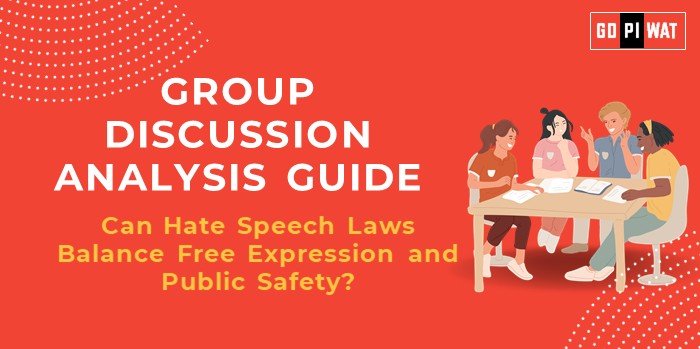📋 Group Discussion (GD) Analysis Guide: Can Hate Speech Laws Balance Free Expression and Public Safety?
🌐 Introduction to the Topic
Balancing free speech with public safety has become a global challenge, especially in democracies. Hate speech laws aim to curb societal harm, but their potential to limit free expression raises ethical and legal debates, making this a critical topic for B-school students.
The origins of hate speech laws trace back to post-WWII international charters, such as the Universal Declaration of Human Rights (1948). Recent controversies, including debates on social media moderation and rising hate crimes, spotlight the tension between safeguarding expression and ensuring communal harmony.
📊 Quick Facts and Key Statistics
- 📈 Hate Crimes Increase: In the U.S., hate crimes rose by 11.6% in 2022, per FBI data.
- 🌍 Global Speech Freedom Ranking: India ranks 161 out of 180 in the 2023 World Press Freedom Index.
- 📜 UN Treaties: Over 150 countries ratify the ICCPR, balancing speech and societal order.
- 💻 Social Media Influence: 60% of hate speech complaints in 2023 originated from online platforms (Pew Research).
🔑 Stakeholders and Their Roles
- 🏛️ Governments: Regulate laws and ensure accountability.
- 💻 Technology Platforms: Moderate content and enforce community standards.
- 🌐 Civil Society: Advocate for victims and challenge overreach.
- ⚖️ Judiciary: Interpret laws in cases of conflict.
🏆 Achievements and Challenges
Achievements:
- ✔️ Germany’s NetzDG law fines platforms for failing to remove hate speech within 24 hours.
- ✔️ Legal enforcement correlated with a 15% decrease in hate crimes in France (2023).
- ✔️ UNESCO campaigns reduced online hate by 25% in monitored regions.
Challenges:
- ⚠️ Lack of a clear definition for hate speech creates subjectivity.
- ⚠️ Risks of misuse for political suppression.
- 🌍 U.S. First Amendment prevents stringent laws, fostering debate.
🎯 Structured Arguments for Discussion
- Supporting Stance: “Hate speech laws reduce societal harm, as shown by Germany’s NetzDG success in moderating online hate speech.”
- Opposing Stance: “Hate speech laws often undermine freedom, evident in India’s frequent internet shutdowns.”
- Balanced Perspective: “While necessary, hate speech laws must align with free speech principles to avoid societal polarization.”
🎤 Effective Discussion Approaches
- Opening Techniques:
- 📚 Begin with a case study, such as Germany’s NetzDG law.
- 📈 Use impactful data like hate crime statistics to frame the urgency.
- Counter-Argument Handling:
- ✔️ Rebut subjectivity issues by citing legal frameworks like the ICCPR.
- ✔️ Emphasize success stories like UNESCO campaigns as solutions.
📊 Strategic Analysis (SWOT Framework)
- Strengths: Prevents harm, builds trust.
- Weaknesses: Ambiguity in defining hate speech.
- Opportunities: Leverage AI for moderation.
- Threats: Misuse for censorship.
📄 Connecting with B-School Applications
- Real-World Applications: Address themes of governance and technology in projects.
- Sample Interview Questions:
- 💡 “How can technology balance free speech and hate speech laws?”
- 💡 “Critique the effectiveness of international hate speech regulations.”
- Insights for Students: Develop AI-driven moderation tools for tech firms and explore ethical frameworks for balancing regulation and freedom.


